Last-Minute NYC Holiday Gift Guide 🎁
We’ve created a holiday gift guide with presents for the intrepid New Yorker that should arrive just in time—


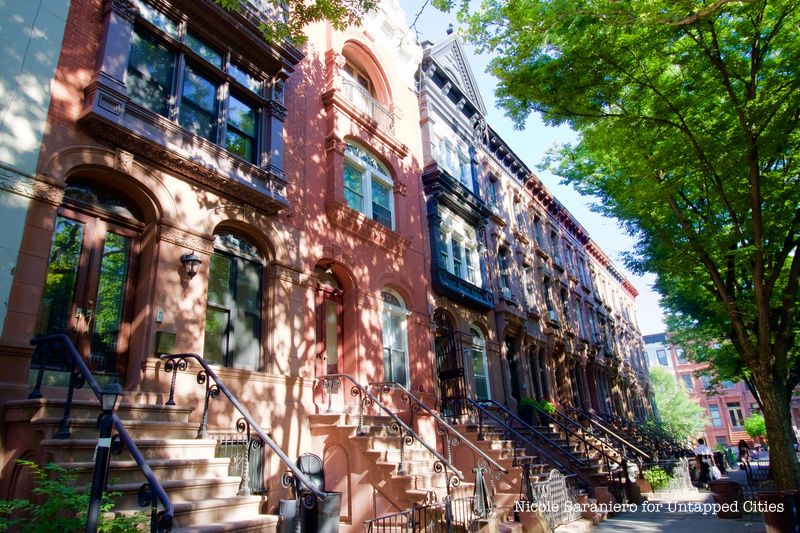
Bedford-Stuyvesant (nickname Bed-Stuy) is one of Brooklyn’s most historic and culturally diverse neighborhoods. The neighborhood has the largest collection of untouched and intact Victorian buildings in the U.S., with hundreds of historic brownstones filling the neighborhood’s streets. For nearly a century, Bedford-Stuyvesant has been a cultural center for the African American community in New York, with many of its current residents descending from families who moved here from Harlem for better housing availability. Figures like Jackie Robinson, Bobby Fischer, Mike Tyson, Jackie Gleason and Jay-Z have called Bedford-Stuyvesant home. The home is also famous for its delectable soul food and Caribbean options. Here are our top 10 secrets of Bedford-Stuyvesant, Brooklyn!
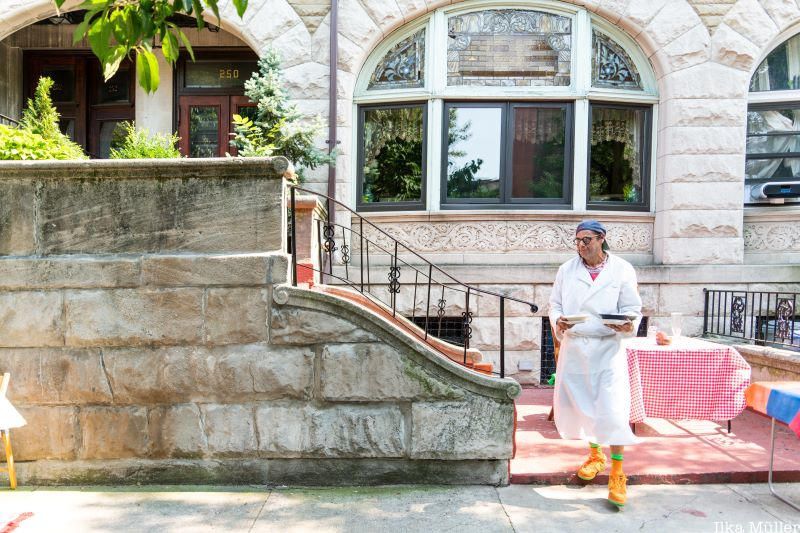
On 250 Hancock Street sits an assuming set of tables with decorative tablecloths, plastic chairs and plenty of people chowing down on appetizing food. Chef Ararat El Rawi runs Little Armenia Cafe, a secret pop-up restaurant serving Armenian specialties. Dishes at the pop-up include appetizers such as tabouli and ceviche, summer pasta and a steak sandwich, and stone fruit soup to finish off the meal.
Untapped New York writer Laurie Shapiro wrote that the pop-up, which only runs on weekends, has a rich backstory. Ararat most recently worked as the lead waiter at Esca, one of the top fish restaurants in the city. He had originally trained in the kitchen in his parents’ restaurant Little Bagdad in Minneapolis, then in fine dining establishments such as Minneapolis’s Café Un Deux Trois under Food Network star Andrew Zimmern, and at Goodfellows (four stars) under Chef Kevin Cullen. He had been on unemployment since his beloved Esca closed from the pandemic, so he opened the pop-up from his apartment kitchen. And while training, he even used to go in the kitchen for Prince’s cook Suzi and learn how to make Prince’s favorite pineapple upside-down cake.
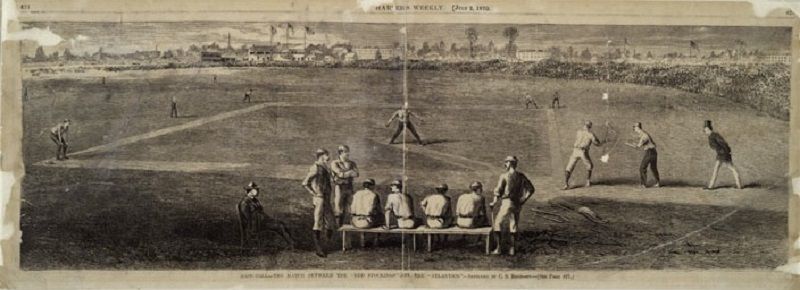
Even the most die-hard baseball fans may not know that there was a baseball stadium in Bedford-Stuyvesant near Halsey Street. Capitoline Grounds was home to the Brooklyn Atlantics from 1864-1872, who joined the professional circuit during the final year they played at the stadium before leaving for a larger field. No remaining traces of Capitoline Grounds can be found at its original location, but it was honored for a short time by a now-closed coffee shop with the same name on Flatbush Avenue.
Even during this eight-year stretch, many monumental events occurred at the popular stadium. At “the finest game ever played,” the Atlantics defeated the Cincinnati Red Stockings, who at the time were considered the greatest team in the world thanks to having the longest winning streak of all time at 84 games. In 1870, the first public display of the curveball was demonstrated by Fred Goldsmith, Ned Cuthbert is credited with inventing the slide at the stadium when he tried avoiding a tag when attempting to steal a base. In a tragic event at the stadium, Washington Donaldson and two reporters attempted to fly a hot-air balloon across the Atlantic Ocean starting in the field, but the balloon crashed in Connecticut and killed one of the reporters on board. And before its demolition in 1880, Capitoline Grounds was used as an ice rink during the winter. Today, there is a coffee shop in Bed Stuy named in its honor.
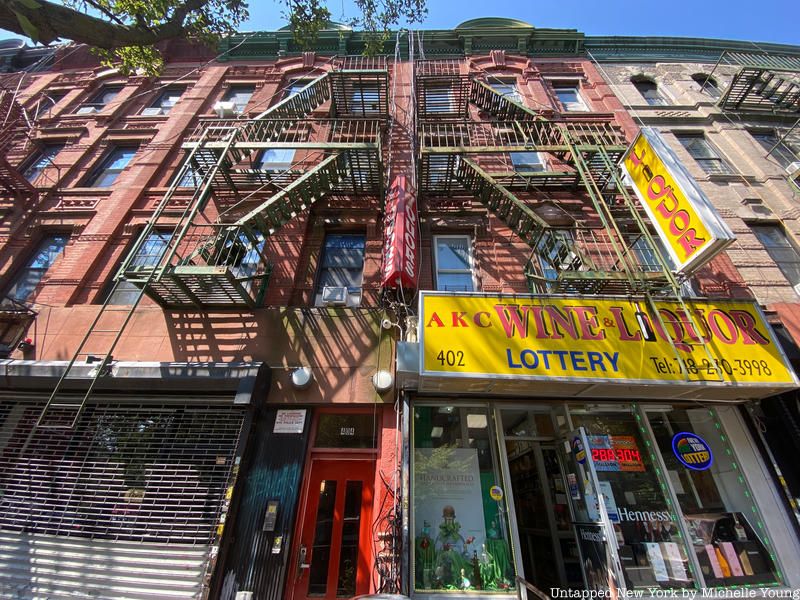
404 Tompkins Avenue, today an unassuming storefront, was actually where the Teddy Bear was created. President Theodore Roosevelt was invited on a hunting trip in Mississippi, during which a black bear was captured and tied to a tree for Roosevelt to kill. Political cartoonists jumped at the opportunity to depict Roosevelt as a lifesaver who refused to kill the bear, and eventually the illustrations began to show the heroic Roosevelt sparing a baby bear cub.
Rose and Morris Michtom, two Russian Jewish immigrants who had a storefront at 404 Tompkins, were so inspired by the cartoons that they made a bear stuffed animal to sell alongside their collection of candy and toys. The bear was velvet with shoe button eyes, and Morris soon after called it the “Teddy Bear” in honor of the president. Roosevelt gave the couple permission to use his name for the product, and contrary to Roosevelt’s own expectations, the bears sold out extremely quickly. They were so popular that the Michtoms sold the store and started selling Teddy Bears full time through their Ideal Novelty and Toy Company, which prompted Roosevelt to use the Michtom bear for his re-election campaign in 1904. Richard Stieff in Germany also invented his own version of the Teddy Bear at around the same time, unaware of the Michtoms’ creation.
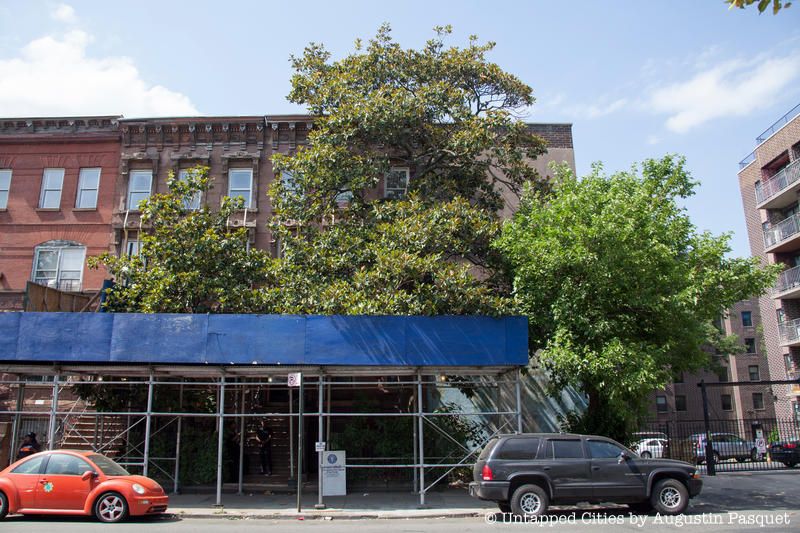
The Magnolia grandiflora in Bedford-Stuyvesant, one of the city’s two landmarked trees (and the only one still standing), is located in front of 678 Lafayette Avenue across from Herbert Von King Park. The tree was planted in 1885 by William Lemken from a seedling from North Carolina. The evergreen tree releases white lemon-scented flowers, and the species was one of the first exotic trees to be exported to Europe. The Landmarks Preservation Commission landmarked the tree in 1970, writing in the official designation report: “It is all the more remarkable, therefore, that the seedling which Mr. William Lemken sent up from North Carolina some 85 years ago…. should have survived so long. It is thus for its inherent beauty as well as for its rare hardiness that this particular Magnolia grandiflora has become a neighborhood symbol and a focus of community pride.”
A local resident named Hattia Carthan was responsible for preserving the tree in the 1950s and raising funds for it in the face of oncoming development. Carthan founded the Magnolia Tree Earth Center in 1972 to bring green programs to Bedford-Stuyvesant and to encourage environmental awareness and youth development in the community. Magnolia Grandiflora is one of the many locations featured in our book Secret Brooklyn.
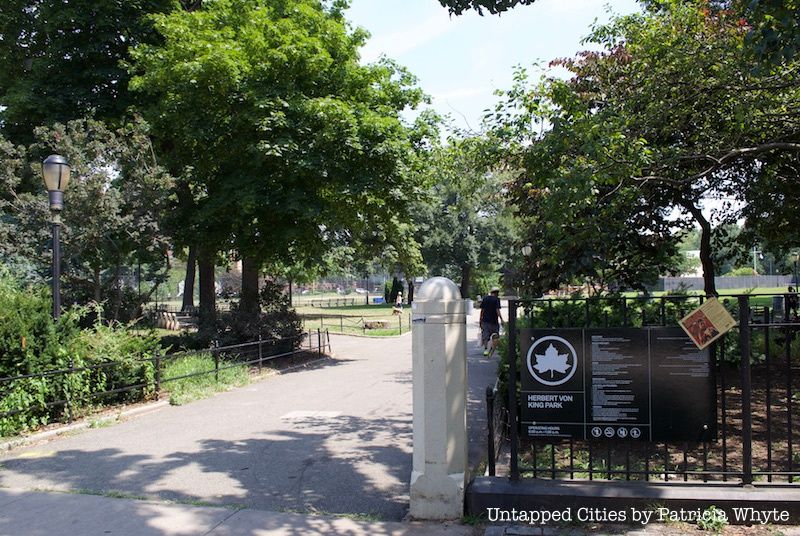
Von King Park, the seventh oldest in the city, was laid out in 1839 after the Village of Brooklyn was incorporated as a city. Originally called Tompkins Park — in honor of Daniel D. Tompkins, an abolitionist who served four terms as governor of New York and two terms as vice president under James Monroe — the park was constructed in 1870 and designed by Central Park designers Frederick Law Olmsted and Calvert Vaux. The design was conceived as a residential space similar to Washington Square and Tompkins Square.
Little of the park’s original design is still present today. The center of the park was opened up in 1915 to accommodate crowds, and a library was built the same year. Remnants of the original park include the 19th-century brownstones surrounding the park and the Magnolia Grandiflora. The park today is named for Herbert Von King, nicknamed the “Mayor of Bedford-Stuyvesant” for his community leadership. He founded Boy Scout Troop 219 in 1933, and the private building contractor also served as a member of the local school board, Police Civilian Committee, and the Magnolia Earth Tree Center.
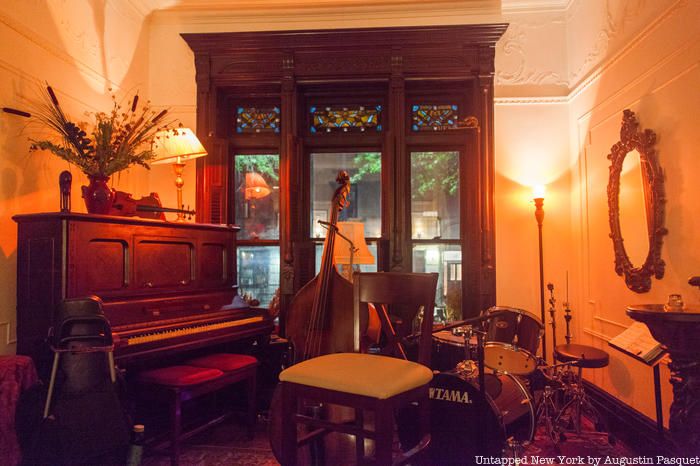
BrownstoneJAZZ at Sankofa Aban B&B is a celebration of music in a historic Brooklyn brownstone, featuring live music in an intimate setting. Jazz performances take place inside an 1880s restored townhouse with many original details. The home is also in the same family for six generations. In addition to performances by jazz combos, concerts are made complete by Southern fish fry meals.
Before becoming an epicenter of hip-hop, Brooklyn featured just as many jazz sites as Manhattan, and most were in Bedford-Stuyvesant. At its height, Bedford-Stuyvesant had about 20 respected clubs that brought in figures like Miles Davis and Max Roach. Jazz greats such as Eddie Heywood, George Russell and Lena Horne called Brooklyn home. BrownstoneJAZZ now is one of the only spots in the neighborhood preserving Bed-Stuy’s jazz history and culture. BrownstoneJazz is another one of the many locations featured in our book New York Hidden Bars and Restaurants.

The one-block Arlington Place in Bedford-Stuyvesant, Brooklyn consists of the work of only three architects, Isaac D. Reynolds, George Chappell and Amzi Hill, lending to its picturesque charm. Reynolds had his office at 263 Fulton Street and is best known for his row houses around Brooklyn. Reynolds, like Hill, gained fame for his Neo-Grec homes, which grew out of the Italianate style. They are brownstone houses but are characterized by their linear ornamentation incised into the flat panels of stone. Hill, who worked nearby at 1161 Fulton Street, worked with his son on many Neo-Grec and Queen Anne-style homes in Bed-Stuy and Crown Heights. Chappell, who also designed a number of homes in the neighborhood, was also a journalist who wrote for Vanity Fair and published over a dozen architecture books.
The block only features about two dozen brownstones, each of which has its own unique character. Arlington Place is one of the neighborhood’s most popular bed and breakfasts; it was the setting for the family home in Spike Lee’s movie “Crooklyn” and opened in 2015. Arlington Place was also a favorite of Charles Lockwood, the author of Bricks and Brownstones. The New York Times selected it as one of the most beautiful small blocks in the city in 2014.
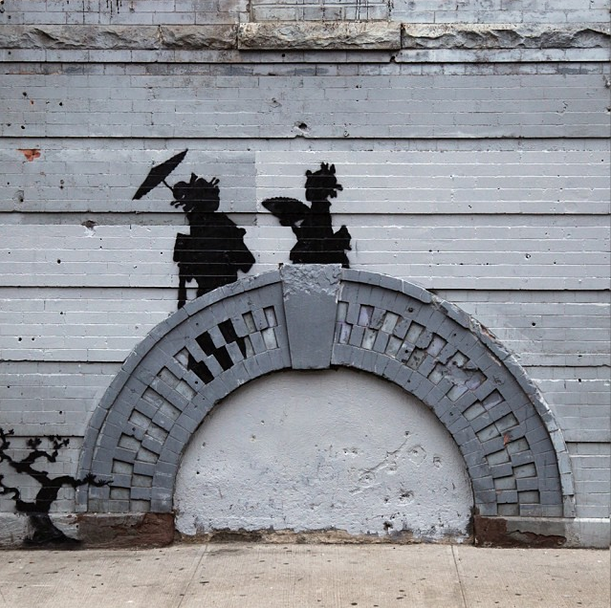
During a month-long residency in New York City in 2013, Banksy installed an architectural detail from an existing building to double as a bridge in Bedford-Stuyvesant. The work featured two Japanese-attired women and a Bonzai tree. The women wear kimono and a wide sash called an obi.
In addition to daily pieces, which suffered paint-overs rather quickly when they were put up, there were roving trucks like “Sirens of the Lambs” and “Mobile Waterfall” that toured the city. There was also a McDonald’s sculpture with a live shoe shiner that traveled a different McDonald’s in the city for two weeks.
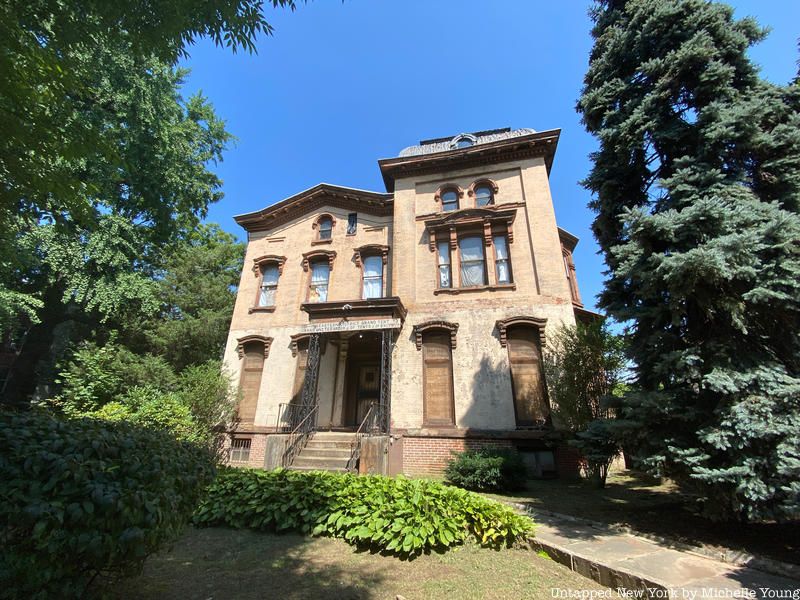
For decades, the United Order of Tents operated secretly in Bedford-Stuyvesant, and few people knew who they were or what they did. But facing declining membership, the United Order of the Tents Eastern District #3 held an event at the Brooklyn Public Library where they shared with the neighborhood about their mission. Its Eastern District headquarters is at a mansion at 87 MacDonough Street that the society bought in 1945. Since then, they have helped feed the hungry, raise children and care for the sick in the community.
The Tents are a Black, Christian women’s group that wears white and calls some members “queens” and all members “sisters.” It was originally founded in 1848 to provide aid to those escaping slavery. The name came from the tents that fugitive slaves used on the Underground Railroad. The United Order of Tents was founded by Annetta M. Lane and Harriet R. Taylor, who were both formerly enslaved. Members over 150 years later try to keep their legacy alive through their work, although they have faced some challenges in getting funding to restore their headquarters. Since they remained secret for so long, securing funding was difficult, but this funding has become more urgent as the headquarters deteriorates and as more potential buyers look to purchase the historic property.
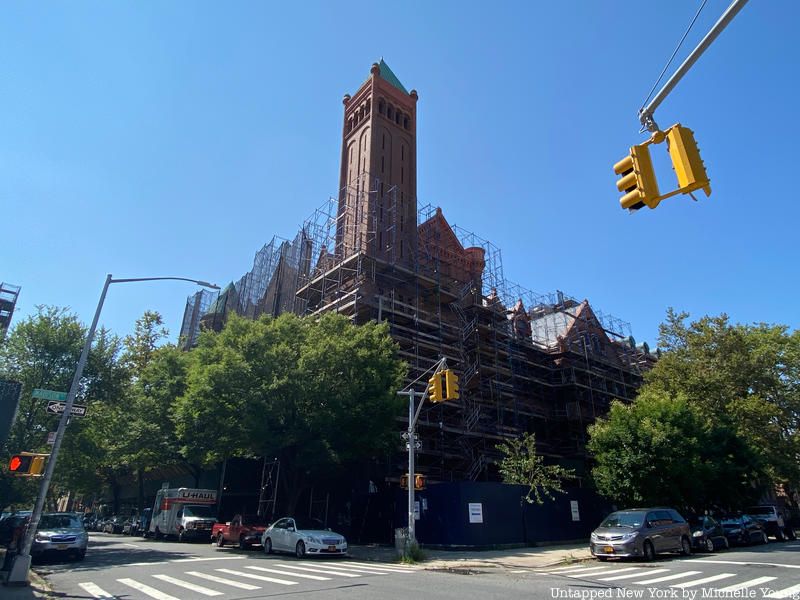
Boys High School in Bedford-Stuyvesant is often considered one of Brooklyn’s finest buildings. The Romanesque Revival building was built using terracotta and features a notable round corner tower and soaring campanile. The architect behind the 1891 building was James W. Naughton, at the time the Superintendent of Buildings for the Board of Education of the City of Brooklyn.
The gorgeous building was also the alma mater of some of the country’s most famous figures. These included Isaac Asimov, a science fiction writer behind the Foundation series; Aaron Copland, the composer of Fanfare for the Common Man and Appalachian Spring; Abraham Maslow, a psychologist who formulated the hierarchy of needs; Max Roach, a jazz percussionist; Man Ray, a Dada and Surrealist artist; and William Levitt, the developer of Levittown. Boys High School is currently undergoing renovations to restore the building to its former glory.
Next, check out 15 of NYC’s One Block Streets!
Subscribe to our newsletter